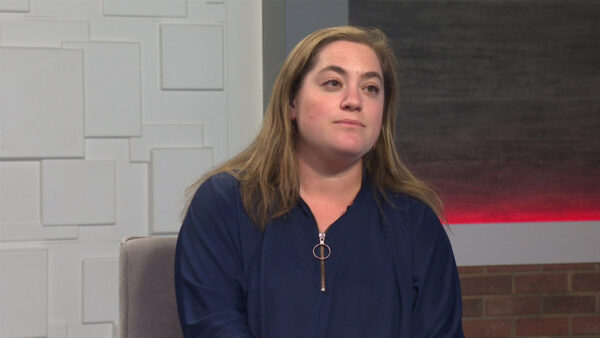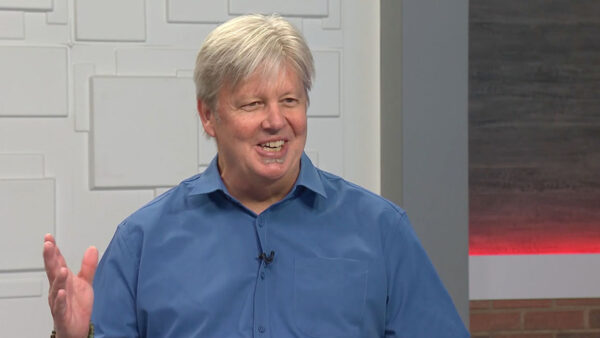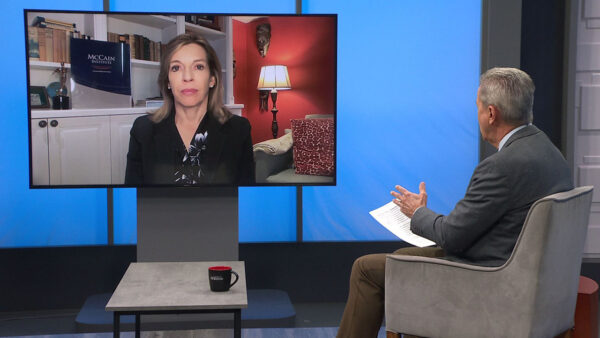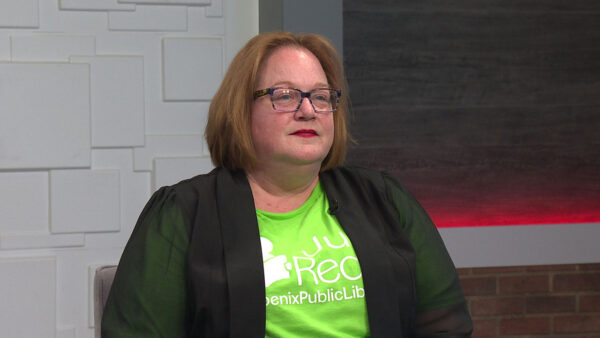Today NASA plans to launch the Lunar Reconnaissance Orbiter marking the first mission in its plans to return man to the moon. We’ll take a look at Arizona State University’s important role in the project.
Ted Simons: NASA is planning to build a manned outpost on the surface of the moon, but first it wants to find the best location. That mission is set to start tomorrow with the launch of a rocket that will carry the Lunar Reconnaissance Orbiter into space. The L.R.O. will go into a low polar orbit about 31 miles above the moon, on board are six instruments that will gather a variety of information, they include a wide angle camera that can identify the mineral composition of the lunar surface and narrow angle cameras that will help identify potential landing sites. Together they're called L-Roc, the lunar reconnaissance orbiter camera. The team in charge of the cameras and pictures they take located right here at A.S.U.
Ernest Bowman-Cisneros: We're in what's called the science operation center for the Lunar Reconnaissance Orbiter camera. This is where we actually generate the commands for the camera to take an observation. We look at the upcoming orbit tracks, figure out what features on the lunar surface we're going to be flying over and decide which of those we want to take pictures of. Build that command file and send that to Goddard space flight center which eventually uplinks it to the spacecraft. Right now the baseline plan is we get turned on July 2nd. That's when what's called first flight, we'll actually turn on the camera and can take our first picture. The excitement for us is that we are the first mission in the return to the moon and eventual astronauts on the surface of Mars. So we're looking to find the resources that we can utilize to build a base on the lunar surface so we're going to figure out where those resources are and then help NASA determine where our good potential landing sites for lunar sortie missions for robotic spacecraft and eventual manned spacecraft landing on the surface and then eventual lunar bases. Building on that then going to Mars.
Ted Simons: A.S.U. professor Mark Robinson is the project's principal investigator. He'll be leading the scientific analysis of data collected by cameras aboard L.R.O. I had a chance to speak with him before he left for Florida for tomorrow's scheduled launch. Mark, thanks for joining us on "Horizon."
Mark Robinson: My pleasure.
Ted Simons: Describe the mission and the implications of this particular mission.
Mark Robinson: Well, the over-arching goals of the mission, are to support a human return to the moon sometime around 2020 time frame.
Ted Simons: So basically the first steps toward going back to the moon here?
Mark Robinson: I would say yes, the first steps on this attempt to return to the moon. There have been a couple of missed steps in the past in the early '90s going back to the moon, but there was a new direction announced for NASA by President Bush in January of 2004 I believe it was, yeah, I think it was 2004. And so we're well along the path right now and that includes L.R.O. as the first robotic mission to help scout out places on the moon where we'd like to go back and to explore and also in parallel there have been development of a launch system to replace the space shuttle. The first system to replace the shuttle, the I believe is now scheduled for a test launch sometime next fall, it's not a full final spacecraft but it's well along the way. Back to L.R.O., the main goals are right now doing polar science, because that appears to be where we'd like to put the first human outposts on the moon, at the poles, for a couple of reasons, one is the poles have a very benign thermal environment. And in the sense that on the moon a day lasts two earth weeks and a night is two weeks long, so look up to the moon and the cycle of the moon is a month. So if you're at the equator night lasts for two weeks and gets very, very cold. There's a huge temperature range on the surface and during the day it gets very, very hot. Whereas at the pole, the changes are much smaller and in fact there are places near the poles where the peaks stick up into the light so they're illuminated for much longer stretches of time and maybe only get dark for three or four earth days and so that might be a really good place to go and put a first outpost because you have nearly continuous solar power. And so L.R.O. has several instruments that are specifically designed to investigate the poles because not only is there an interesting thermal environment there, there may be volatiles trapped in permanent shadow craters.
Ted Simons: So basically A.S.U.'s part in this mission, we're talking cameras here, describe the cameras and how close are these things going to wind up get together lunar surface?
Mark Robinson: Well, the spacecraft itself scissor bit 50 kilometers circular, so only 50 kilometers above the surface, which is about 30 miles, so it's a very low orbit and there are actually three cameras that A.S.U. are providing to the mission. Two of them are very high resolution black and white cameras called the narrow angle cameras and there is another camera which is the wide angle camera which images in the U.V. and invisible colors. And its role is to map out color differences on the surface that can relate back to compositional differences. Narrow angle cameras are black and white and they can see a piece of ground about this big in terms of each pixel. So the resolution is 50 centimeters.
Ted Simons: In general what are we going to learn from this mission and how are these cameras going to help us?
Mark Robinson: Well, in terms of the human return, there's -- there are many within almost any large project that you do, but the very high resolution black and white cameras are going to take several different kinds of images, you know, there's just the normal looking straight down taking a picture and then we can come back later in the same area and tilt the spacecraft over and get a stereo image, so then we can combine those and make a very high resolution topographic map. And then we will also take pictures of these areas when the sun is low on the horizon, shadows are cast and it really enhances the topography, so let's say if you were standing on the surface, we wouldn't be able to tell that it was a person, but we would be able to see that there was something there, because you'd be casting this long shadow, right. We'll also take pictures when the sun is right overhead at nearly noon time because that enhances albito differences, a fancy word for how much light does something reflect. That piece of paper says very white so it's high albito and your jacket is dark, so it has a low albito. It tells us about the composition of the surface in a very fundamental invasive way and the lower resolution color helps us also to determine compensation on the surface. But we're looking for places to go and land, safe and scientifically engaging and we have a general idea of many different places and in fact NASA, has this list of their 50 top places that we're going to investigate on the moon and to help narrow them down, we'll be taking images over the course of the 14 months nominal mission of all these areas both in data looking and off data for stereo and combined with data.
Ted Simons: Sounds fascinating. Last question here, A.S.U. involved obviously this project, future projects for A.S.U.? What do you see out there?
Mark Robinson: Well, A.S.U. as you know has a long involvement with space missions, if you go right down the street here there's the Mars space facility and there's been I can't even remember how many missions, at least three in the recent past where A.S.U.'s been involved. I'd really like to see us involved in future lunar exploration. The whole lunar program right now is very hazy and we have a new president and he's reevaluating NASA's course right now in terms of human space flight and exploration of the moon and there's this Augustine commission that's starting up right now and they're supposed to report back at the end of the summer, is the course we're on where NASA should be going, in terms of human space flight, and the robotic program follows along with that to a large degree. So I would say let's hold that question until the Augustine commission sends their report back early fall.
Ted Simons: All right.
Mark Robinson: But I'd love to be involved and A.S.U. will be involved in some way, whatever course we take.
Mark Robinson:ASU professor;























